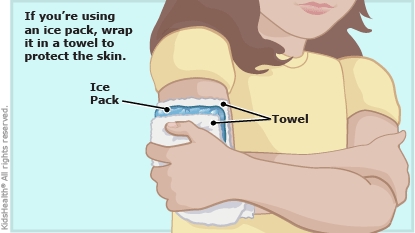Elbow Pain: How to Care for Your Child
Elbow pain can happen for different reasons. It can come on slowly or suddenly and often gets worse with use. Most cases of elbow pain are not serious and go away with rest and basic home care.


-
If given a sling, help your child to wear it while awake as instructed.
-
If given a supportive wrap, have your child wear it as directed and talk to the health care provider about whether it should be worn during activities.
-
Your child should rest the elbow and only do activities that do not cause pain or discomfort.
-
If your child is uncomfortable, you can give acetaminophen (such as Tylenol® or a store brand) OR ibuprofen (such as Advil®, Motrin® or a store brand), if recommended by your health care provider.
-
Putting a cold pack on the elbow for 15–20 minutes every 3–4 hours may help. Put a towel or cloth between the cold pack and the skin.
-
Schedule any follow-up appointments as directed.
-
If the pain continues, your health care provider may refer your child to a physical therapist or an orthopedic doctor (bone specialist).
-
Follow your health care provider's instructions about when your child can return to sports.

Your child:
-
still has pain after following the care instructions
-
has pain that gets worse
-
wakes at night from the pain
-
has trouble straightening or bending the elbow, or the elbow makes a popping sound when it moves
-
has pain in other areas of the body
-
has other symptoms, like fever or rash

Your child has:
-
cold, pale or blue hand or fingers
-
severe pain
-
signs of infection, such as fever, warmth or redness around the elbow
-
numbness or tingling in the arm or hand

What can cause elbow pain? Elbow pain may happen from strain, a tear or swelling in the:
-
ligaments (bands that connect bones to other bones)
-
tendons (bands that connect muscle to bone)
-
muscles
-
connective tissues (which support the body's organs, bones and muscles)
Elbow pain also can happen from a deep bruise, or from not resting the elbow after activity — especially after sports with a lot of throwing or hitting. Less common sources of pain include infections, arthritis, cysts or growths on the bones. Elbow pain may feel like an ache, soreness or sharp pain.
Sometimes it can take more than one visit to find out the cause of elbow pain.